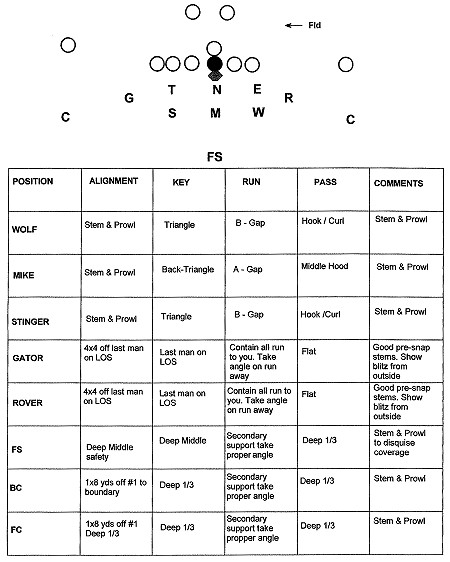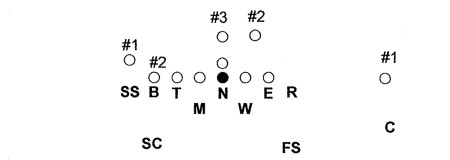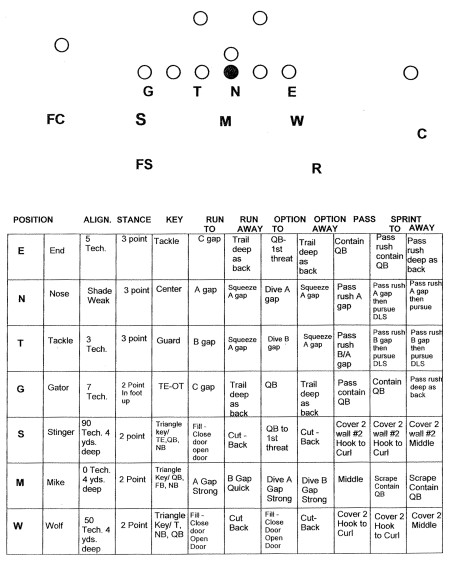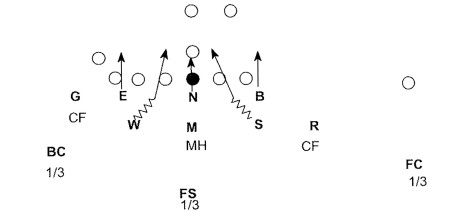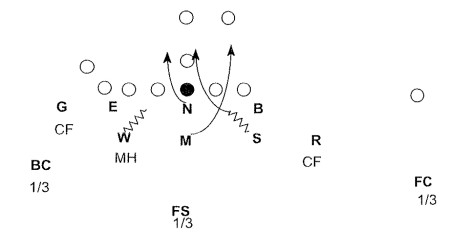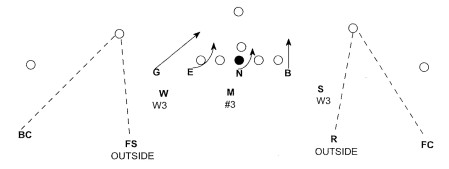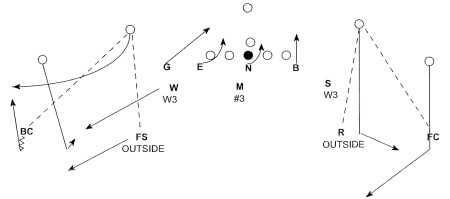Article CategoriesAFM Magazine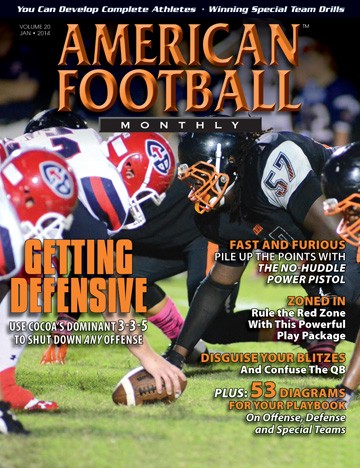
|
Getting Defensive – Cocoa High School’s base 3-3-5 defense shuts down nearly every opponent they face.by: Dallas JacksonRivalsHigh.com © More from this issue When you ask Cocoa High School Head Coach John Wilkinson about his personal philosophy, it’s very obvious what motivates him. “I want winners because I want to win,” he said. “I want to do whatever it takes to win. It may sound simple but, to me, there is something very different between competing and winning.” And win he has. In his nine-year career at Cocoa, Wilkinson has a record of 100-19 which includes three Florida 4A state championships, a 38-game winning streak, a Florida Coach of the Year award and a spot in the Florida Athletic Coaches Association Hall of Fame. Those wins have not just come against Cocoa’s neighbors on Florida’s Space Coast. Each year, the Tigers have scheduled games against top national opponents and have beaten powerhouse programs like Abilene (TX), Olive Branch (MS), Bergen Catholic (NJ) and Thomas Jefferson (PA). If it weren’t for losses in the Florida playoffs the past three seasons to the nation’s top-ranked team, Miami’s Booker T. Washington, Wilkinson likely would have added more championships to his resume. For Wilkinson and Cocoa, winning starts with defense. Over the last five seasons, Cocoa has yielded an average of 7.2 points per game on their way to a 58-8 record, including 24 shutouts. And this is supposed to be the era of fast-paced, high scoring offenses. For Wilkinson, the success of Cocoa’s defense is not accidental. “I know a lot of people are going to the spread and looking to just outscore teams so maybe we are unique in looking at defense first,” he said. “I know offense will put people in the seats but defense wins championships and that is what we want to do.” Cocoa has run a 3-3-5 stack defense for much of Wilkinson’s tenure. Many times there is such little variance in the size of his players and disguising of blitzes that it looks like a 3-8 on film and position designation is hard to identify. He said that the formation isn’t conventional but, with the talent he has, chooses to run this defense.
Diagram 1: Cocoa’s base defense with position responsibilities Cocoa’s talent pool is limited, which makes their success even more remarkable. Wilkinson’s 2013 squad consisted of just 35 players, and that’s after five were promoted from JV for the playoffs. Still, it was the deepest roster he’s had at Cocoa. “From a football perspective, with a roster of 35 players, we just can’t line up in certain defenses and be successful,” Wilkinson said. “So we really stay true to the philosophy that gives us the best chance to win and that’s having our best 11 players on the field as much as we can. “That is really what I think makes us a little different. If we come out and don’t have the personnel to run it, we’ll move to something else. A coach who sticks with a style of play that doesn’t play to the strengths of their players, in my opinion, is not giving his team the best chance to win. The 3-3-5, though, is perfect for us. We won’t just stay in a base defense. What makes it work is a lot of combinations of slanting, stunts, blitzing and disguising our looks. Wilkinson said he remembers a season when it was nearly impossible for opponents to know which players were going to come from what area of the field. “We had a year where I don’t think we had anyone over 220 pounds on defense,” he said. “There were 11 kids starting for us that were all between 5-10 and 6-foot-2 and between 185 and 200 pounds. We struggle to find kids with size. I’d love for them to be bigger but around here they just aren’t. So we put our best 11 on the field regardless of size.” This year – blessed with two players over 260 pounds – the defense spent time in a 4-2-5 as well as the 3-3-5. Defensive Coordinator Bobby Holloway has been coaching since 1981 and has been on staff with Wilkinson for eight of the nine years. Holloway was able to include a few five-man fronts against the I-based offenses Cocoa faced. “For the most part, we need to be a fast defense,” he said. “We had a couple of slower big guys this year but generally all of our defensive linemen will be under a 5.0 in the 40-yard-dash and our linebackers and defensive backs are all running under 4.7. Historically, we have had our most success in our stack but we played some Cat (5-2), some Panther (4-3), and some Bear (4-6), too. Our best players dictate what we play more than our coaching style.” All of the varieties of defense stay in the weekly game plan but some may not be used for an entire contest. Wilkinson said that each has its own purpose and place to move out of the 3-3-5. “For example, the Cat defense is more of our 50-front,” he said. If we have the personnel, we will sub in a bigger defensive lineman and move another down. We will keep seven in the box and play man on the outside. We will use this defense when our opponent is starting to run right at us but, with more teams going to the spread, it isn’t something we have to do too much.” (Diagram 2 – Cocoa’s 5-2 Cat defense with position alignments).
Diagram 2: Cocoa’s 5-2 Cat Defense Another defense Cocoa uses is their 4-3 Panther look. “We will use this defense often if our opponent is showing a trips formation,” said Wilkinson. “It allows us to disguise things a little more than Cat because we can go zone behind it instead of man-to-man. So there is some flexibility but the success of this defense is having bigger defensive linemen and we rarely have guys with that kind of size.” (Diagram 3 – Cocoa’s 4-3 Panther defense with position responsibilities).
Diagram 3: Cocoa’s 4-3 Panther Defense Wilkinson will change the defensive gameplan weekly based on the opponent’s strengths and weaknesses. Player assignments can change on the fly. “We will have a guy down in a five-technique based on something we saw in the film,” he said, “but in the game it may not be working and we will get his hand off the ground. It all depends.” Cocoa uses specific slants, stunts and blitzes depending on the opponent’s formation and the down and distance. Wilkinson breaks down three – Saw 43-3 Fire, Sam 24-3 fire and Goat 80:
Diagram 4: SAW 43 Fire SAM 24 3 Fire
Diagram 5: SAM 24 3 Fire GOAT 80
Diagram 6A: Goat 80 vs. 2 X 2
While Wilkinson has rarely had a bevy of big players, he has his own projections for each position. “Ideally, our defensive linemen are going to be around 225-or 235-pounds that can change direction,” Wilkinson said. “These are not going to be the burners, but guys with some quick-twitch to their game and more quickness than straight ahead speed. We are going to be getting after the passer and using slants and quickness to our advantage so if an offensive tackle can’t get his hands on our ends, then size doesn’t matter. If we can get a guy around 245 pounds who is tough, that will give us a great inside anchor.” His linebackers tend to serve a dual-role as tight ends on offense but need a toughness that Wilkinson demands on the other side of the ball. “These are our ‘Nasty Boys,’ “ he said. “They are probably the same size as our safeties at about 180 - 200 pounds that like to be hitters and enforcers. They are our next-level athletes with more straight line speed but not as fluid in the hips as the skill players. We have a lot of kids that want to play football at 5-foot-10, or 5-foot-11 and 175-pounds. We rarely have a tough time finding cornerbacks here. “We are very fortunate to have good kids out here,” he said, “but they all know that we expect them to be at their best. That is all a part of winning in everything and I tell them all the time that if they can put up with me, then good things will happen. There are no free rides on this team and we don’t just take kids so that our roster has inflated numbers. There is not one player out there just standing on the sidelines to say they are wearing the jersey. Having a roster with 100 kids is nice, I guess, because you have more to pick from to find your best 11 but you can only play those 11 at one time and probably only 30 throughout the game. Our kids will have something invested of themselves in the program and I think that will make them play harder because of it. On the flip side, we do our best to reward them for that effort.” Over nearly a decade, Cocoa High’s players have rewarded John Wilkinson with stellar play, stingy defense, and championships. It’s “defense first” at Cocoa and that philosophy has paid off in a big way. |
|
| HOME |
MAGAZINE |
SUBSCRIBE | ONLINE COLUMNISTS | COACHING VIDEOS |
Copyright 2024, AmericanFootballMonthly.com
All Rights Reserved


